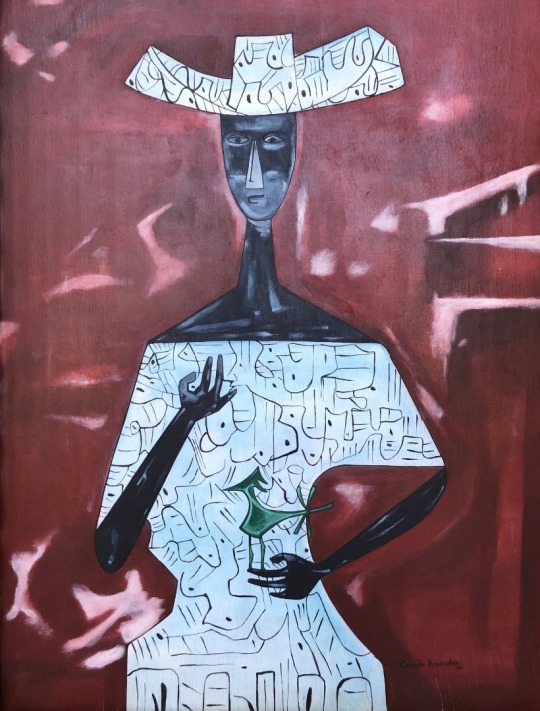#Cundo Bermúdez
Explore tagged Tumblr posts
Text

Cundo Bermúdez (Cuban,1914-2008)
Mujer Con Redecilla Blanca, 1943
Gouache on board
43 notes
·
View notes
Photo

CUNDO BERMUDEZ (CUBAN 1914-2008)
El Almuerzo, 1960
oil
© Invaluable
5 notes
·
View notes
Text
Triunfos y Sorpresas en la reciente Subasta de Arte Latinoamericano: Christie´s Marzo 2024

View On WordPress
#Agustín Cárdenas#Amelia Peláez#Ariamna Contino#Carlos Garaicoa#Cundo Bermúdez#hablandodemercadodearte#María Magdalena Campos#Mariano Rodríguez#Mario Carreño#Roberto Fabelo
0 notes
Text

🎨Cundo Bermúdez, Barbería, 1942
Oleo sobre lienzo / 63.8 x 53.7 cm
📍Col. MoMA
6 notes
·
View notes
Text

Figura
Cundo Bermúdez
oil on canvas, 1989
7 notes
·
View notes
Photo

Cundo Bermúdez (Cuban, 1914-2008), Interior con espejo y puerta al mar, 1965. Oil on canvas, 89.2 x 61.3 cm
165 notes
·
View notes
Photo

Cundo Bermúdez - Mujeres con peces (women with fish)
2 notes
·
View notes
Text

Cundo Bermúdez (Cuban,1914-2008)
Mujer con el Pájaro Verde, 1954
Oil on panel
53 notes
·
View notes
Text
Historical Close-Up: Modern Cuban Painters at MoMA, 1944

In a photographic detail, María Luisa Gómez Mena stands with a core group of artists and critics in the doorway of Galería del Prado, c. 1942-1944. Gómez Mena stands sixth from the left, in front. Others in the shot include José Gómez Sicre, Mario Carreño, Cundo Bermúdez, Alfredo Lozano, Amelia Peláez, Mestre, MLGM, Roberto Diago, and Eugenio Rodríguez.
"... On March 17, 1944, the Museum of Modern Art opened the exhibition Modern Cuban Painters. Organized by Alfred H. Barr, Jr. in consultation with a young Cuban art critic and curator by the name of José Gómez Sicre, the exhibition was hailed by the art criticism establishment, from the conservative Royal Cortissoz to the more liberal Edward Alden Jewell. In Art News, H.F. Kraus described it as 'an exhibition of color and verve and home grown baroque sensibility . . . very different from the Mexican work seen in these very galleries four years ago.' Cuban art was not a complete stranger to New York audiences. ..."
Historical Close-Up: Modern Cuban Painters at MoMA, 1944, Part 2: Spotlight on María Luisa Gómez Mena, Part 3: More on Maria Luisa Gómez Mena

An exhibition at the Galería del Prado, c. 1942. The works on view include pieces by Amelia Peláez, Mario Carreño, Felipe Orlando, and Mariano Rodríguez.
1 note
·
View note
Photo

Cundo Bermúdez (1914-2008) La Flautista, 1950 (84.7 x 66 cm)
11 notes
·
View notes
Photo

Cundo Bermúdez (September 3, 1914 – October 30, 2008), born Secundino (Cundo) Bermúdez y Delgado, was a Cuban painter. Born in Havana, Cuba, he died of a heart attack in his Westchester home on October 30, 2008. __________________________________ CUNDO BERMUDEZ [Cuban b.1914] Untitled, 1960 Oil on masonite 33 ½ x 23 ½ In. 85.1 x 59.7 Cm. Provenance: Gary Nader Collection, Miami, FL #womeninart #virtualexhibition #art #nadermuseum #womaninart #womaninlatinamericanart #nadermuseum #artlover #fridakhalo #carmenherrera #marthaboto #taniabrugera #leonoracarrington #ligiaclark #olgadeamaral #elianeduarte #gego #beatrizmilhazes #ameliapelaez #betsabeeromero #dorissalcedo #olgasinclair #lolosoldevilla #alexisleyvamachado #cuban #bermudez #garynader #garynadtrartcentre #cundobermudez (at Gary Nader Art Centre) https://www.instagram.com/p/CCrqugmAUQg/?igshid=1atmi5iv6ncg0
#womeninart#virtualexhibition#art#nadermuseum#womaninart#womaninlatinamericanart#artlover#fridakhalo#carmenherrera#marthaboto#taniabrugera#leonoracarrington#ligiaclark#olgadeamaral#elianeduarte#gego#beatrizmilhazes#ameliapelaez#betsabeeromero#dorissalcedo#olgasinclair#lolosoldevilla#alexisleyvamachado#cuban#bermudez#garynader#garynadtrartcentre#cundobermudez
0 notes
Text

Cundo Bermúdez (Cuba 1914-2008) - La mujer en la playa, The Woman on the Beach (1982).
0 notes



